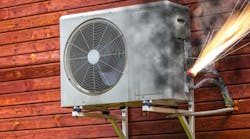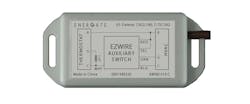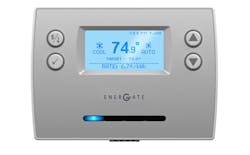Download the PDF of this article.
In an earlier post, I described how a snafu with my Nest thermostat led to me pulling a new cable to get things working. This solution worked out well for me, since replacing the cable turned out to be relatively easy. That isn’t always the case, however. The alternative would be to forego a new Wi-Fi-enabled thermostat like the Honeywell version I switched to. Or so I thought.
It turns out that there’s more than one way to solve the problem.
Energate’s EZwire (Fig. 1) is a box that sits next to an HVAC system and adds common wire support to a thermostat system. It works with existing 2-, 3-, 4- and 5-wire systems. There is a jumper added at the thermostat end, but the existing cabling is used between the thermostat and the EZwire box.
1. Energate’s EZwire module sits next to an HVAC system and adds common wire support without requiring an additional wire.
The EZwire system will work with thermostats like the Nest and the Honeywell I wound up switching to. Since it has no need to resort to the Nest’s power-stealing approach, it won’t encounter the problem I had with the air conditioner’s contactor (relay) wearing out.
EZwire is just one of Energate’s products: It also has intelligent thermostats (Fig. 2). The HōlHōm+ (pronounced “whole home”) solutions can provide advance home energy management even in areas that have yet to deploy the Advanced Metering Infrastructure (AMI).
2. Energate also sells intelligent thermostats that can be tied into the billing system to show how much power is actually costing you.
As is turns out, Energate’s EZwire isn’t the only add-a-wire solution on the market. Venstar Add-a-Wire can turn a four-wire into a five-wire system or a five-wire into a six-wire system. It uses a diode at the thermostat end.
If you have or are looking at a Honeywell thermostat, check out the Honeywell THP9045A1023 Wiresaver Wiring Module (Fig. 3). It uses the “K” terminal on thermostat, which winds up controlling the Y and G signals on the HVAC equipment.
3. In the market for a Honeywell thermostat? Check out the Honeywell THP9045A1023 Wiresaver Wiring Module.
I have also been looking for a thermostat that only uses two (or maybe three) wires with a smart device at the HVAC end. A pair of wires can provide power and a bidirectional communications link. Unlike the analog approach, a digital communication system would not be limited to the number of connections at the HVAC end, so it could actually be used for additional devices such as humidifiers.
Fast-Stat actually has a range of HVAC wire extender solutions that address all the combinations already mentioned, as well as versions that add as many as four wires to a system. They tend to be more expensive than the solutions that add a single wire to the mix, but it will usually be less expensive than pulling a new wire.




